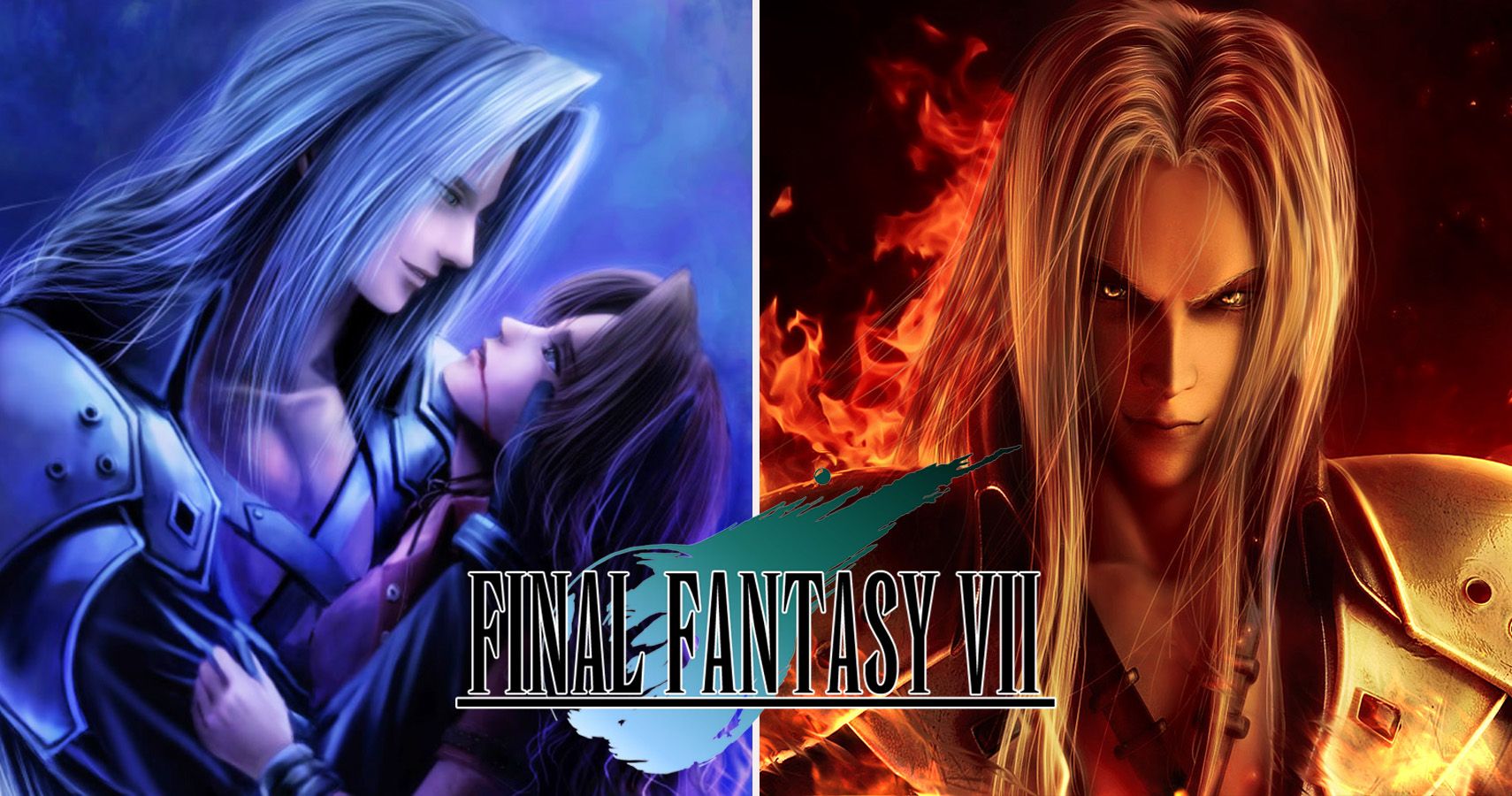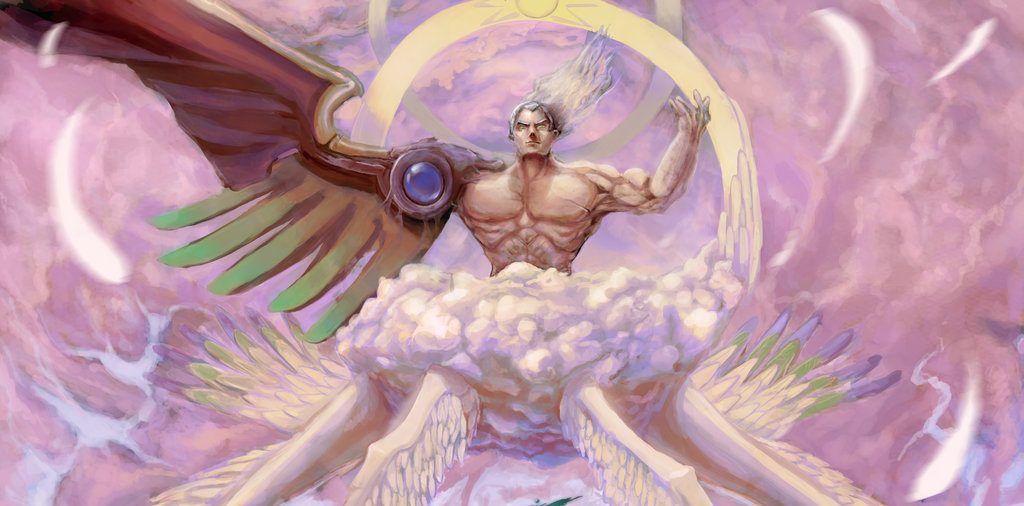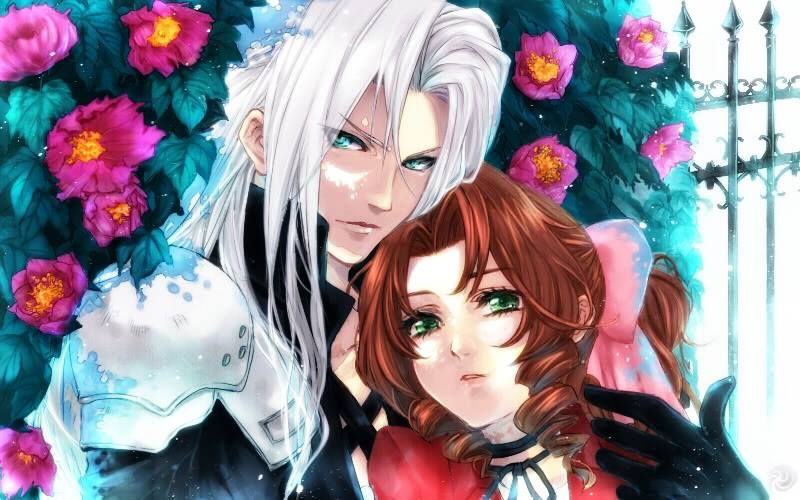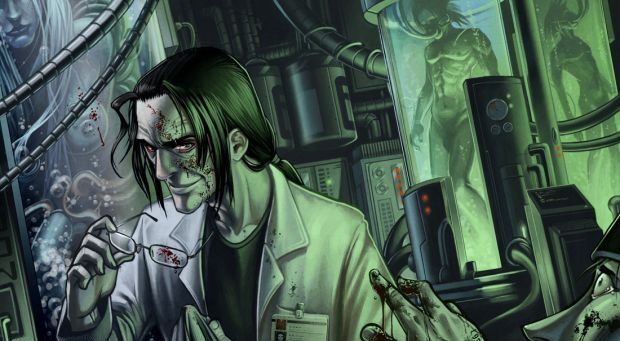It's hard to talk about the Final Fantasy series without bringing up one of the most popular video game villains of all time: Sephiroth. He's the most well known villain throughout the multiple Final Fantasy games and arguably one of the most popular villains in video games in general. While Final Fantasy VII is a great game in its own right and is the title that made the JRPG genre popular in North America, it's kind of hard to imagine the game becoming as popular as it did without such an iconic villain such as Sephiroth. He's the kind of villain that you absolutely love to hate, and after a key scene after the game's first disc, he became a villain I absolutely had to defeat rather than a means to an end.
While Final Fantasy VII has an amazing storyline, the plot became quite convoluted after some time. This could be blamed on a somewhat shoddy translation of the original title or due to the multiple spinoffs Square-Enix released under the Compilation of Final Fantasy VII complete with its own film, third person shooter, mobile game, and quite possibly its own breakfast cereal with Sephiroth shaped marshmallows. While this expanded on the Final Fantasy VII universe, it may have raised more questions about the infamous man in black rather than questions answered leaving many gamers in the dark about certain facts pertaining to his existence.
Sephiroth is by no means a villain to take lightly and is one of the most powerful beings in the entire franchise, not only harnessing the power to take over the world but to destroy other worlds as well. With that kind of power, the man has rightfully earned his place as one of the most terrifying video game antagonists. Despite his strength and power, it's important to know your enemy, and with that said, these are some facts about Sephiroth that you may not know.
20 He's No Stranger To The Darkness
It should come as no surprise that one of the most famous villains in the Final Fantasy franchise has a heart that's shrouded in darkness. While we know that Sephiroth is already an admirable foe within the Final Fantasy VII universe, he's just as vicious in his guest appearances within the Kingdom Hearts universe.
Sephiroth already has a myriad of devastating attacks in Final Fantasy VII, and while we're thankful we didn't have to sit through his minute-long "Supernova" attack in Kingdom Hearts, he's surprisingly even a more difficult battle in the Disney title than in his first game. The Kingdom Hearts version of Sephiroth has the ability to harness the powers of the darkness within his own heart. He can use powerful attacks like "Sin Harvest" or the ability to teleport, which is commonly known as an ability of the darkness as we typically see Malificent or Organization XIII using it. While Sephiroth may not have the same lofty goals that he had in Final Fantasy VII, he's only grown in strength since the game's final battle.
19 He's Pretty Much A Blank Slate
Strangely enough, Final Fantasy VII and the Compilation of Final Fantasy VII seem to completely ignore all aspects of Sephiroth's childhood, despite the fact that it was most likely well documented in the game's world and has little reason to be much of a mystery. In that respect, Sephiroth is painted as a more interesting villain due to him being shrouded in mystery.
It's likely that Shinra kept tabs on Sephiroth throughout his life as he was experimented on in their labs since childbirth and ultimately became part of the elite military organization SOLDIER. But other than that, Sephiroth is pretty much a blank slate who likely didn't have much of a childhood. He never knew who his mother was and Professor Hojo was more than likely a terrible father figure as Sephiroth held him with little regard. The only line we see alluding toward his childhood is Sephiroth stating that ever since he was a kid he always felt different from others. Regardless, Sephiroth is not someone I would want other kids to play with on the playground.
18 He's Barely A Human
After the events of Final Fantasy VII, gamers probably suspected for a long time that Sephiroth had met his end to Cloud's Omnislash in the final battle, despite the somewhat open ended finale in the games ending sequence. Having been crushed into a bloody pulp, it seemed that Sephiroth's terror was at an end, but unfortunately for the Planet, such was not the case.
Returning in the film Advent Children, Sephiroth was pretty much resurrected from the dead. Sephiroth's character designer Tetsuya Nomura wanted to depict Sephiroth somewhat differently in the film sequel in order to convey Sephiroth having ascended to a different level of existence. He stripped Sephiroth away of basic human characteristics such as blinking, grunting, or breathing. While most versions of Sephiroth don't follow this direction, Advent Children's Sephiroth is always seen as cool and collected during the battle between him and Cloud.
17 Playing Devil's Advocate
The Final Fantasy series has never been a stranger to religious allegory and Sephiroth is certainly no exception. Sephiroth's penultimate form which serves as the game's actual final boss fight depicts Sephiroth as an angel, though it's hard to be fooled by his appearance after all the sins he's committed. While Sephiroth may view himself as a God, he more likely represents a fallen angel.
Ironically, Safer Saphiroth's theme song "One-Winged Angel" plays in the background during this boss fight, yet the name is a little misleading as he actually has seven wings. While the wing on his right arm looks to be more for show and obviously is the wing the song references, the six wings beneath Sephiroth's body are what actually keep him afloat, likely representing the six wings Lucifer, another fallen angel, has in Dante's Inferno. The parallels between Sephiroth and Lucifer appear throughout the game as Sephiroth was once idolized by a younger Cloud Strife. In his struggle to become a God and gain more power, Sephiroth betrays the world around him. While Sephiroth's right wing in the original Final Fantasy VII was depicted as being quite colorful, later versions changed the wing's color to black, in order to convey Sephiroth's darkness.
16 What's In A Name?
Sephiroth's religious symbolism probably doesn't come off as much of a surprise due to the frequently used imagery of him as an angel, yet it doesn't necessarily stop at his physical design alone. The name Sephiroth derives from the word sefirot, which literally means "counting." Sefirot comes from the Kabbalah, which is a school of thought originating from the Judaic religion. There are ten sefirot on the "Tree of Life." Each sefirot depicts an "illumination of God's infinite light" that shows up in God's creation. Through these ten sefirot, God reveals his will. The term sefirot ties into Sephiroth's character as he wishes to become a God himself, creating a wound in the Planet in order to feed off the Lifestream while it is healing the world. Absorbing the Lifestream's power, Sephiroth would ultimately ascend into a God-like status.
15 Earlier Drafts Depicted Sephiroth As A Female
If something is absent from the Final Fantasy series, it is the appearance of more female villains (and quite frankly, we could see more lead heroines as well). While Final Fantasy VIII did deliver a fantastic female antagonist through Ultimecia, we haven't seen a female villain that fierce and wicked for quite some time.
Surprisingly enough, Sephiroth was originally planned to be a female according to Tetsuya Nomura's earlier drafts of the game's popular villain. Whether or not this was going to be something that was obvious from the beginning of the game or not, Sephiroth was initially going to be first encountered in the Northern Crater when Sephiroth's physical body was first revealed. This idea was most likely scrapped in order to better convey the rivalry between Cloud and Sephiroth.
14 Cloud And Sephiroth's Rivalry
While rivalries have found their ways in and out of the Final Fantasy franchise, no rivalry is better known that that between Cloud and Sephiroth (though Squall and Seifer's rivalry from Final Fantasy VIII is arguably better). Character designer Tetsuya Nomura wanted to base their rivalry on actual Japanese historic figures, being legendary swordsmen Miyamoto Musashi and Sasaki Kojiro. Tetsuya wished to replicate the animosity between the two famous swordsmen, which was most noticeable in Cloud's hatred toward the hero he once idolized as a child. Since both Cloud and Sephiroth carry two of the most popular swords in the history of video games, the Buster Sword and the Masamune respectively, it makes sense that the two would be based off of Japanese swordsmen who also carried oversized weaponry.
13 He Will Even Kill His Most Beloved
While the following factoid might not be canon to Final Fantasy VII's lore, it's definitely interesting to look at as Sephiroth's original backstory was drastically different than what we are familiar with today. Tetsuya Nomura originally wanted to depict Sephiroth as being Aeris's sibling, which is why both characters have similar hairstyles and facial features. This idea was axed and Sephiroth was later written as Aeris's lover, until Zack Fair was written into the script.
The shift in direction toward Sephiroth's backstory was most likely a good choice as it made Sephiroth more mysterious and left us with more questions than answers. While other elements of the story may have changed as well, if things stayed as originally drafted, we would have seen a merciless Sephiroth murdering either his own blood or his lover. While this scenario didn't make its way into the game we know today, it's an interesting spin on Sephiroth's character that really shows how heartless he is or could have potentially been.
12 He Can Manipulate Jenova Cells
The only thing that could be more terrifying than having to fight against one of the most powerful beings in existence is the idea that that being could control you at almost any moment. While Cloud might be seen as a failed experiment in the mind of Professor Hojo, he is unfortunately still a useful tool in Sephiroth's scheme to ascend to a God-like existence. Due to Cloud being injected with Jenova cells after the events in Nibelheim five years prior to the events of Final Fantasy VII, Cloud becomes somewhat of a puppet to Sephiroth as he is able to manipulate the Jenova Cells in Cloud's body. Because of this, Cloud repeatedly becomes a bit of a burden on his fellow teammates to say the least, whether it's almost attacking Aeris while under Sephiroth's control or ultimately causing the summoning of Meteor due to him handing over the Black Materia to a comatose Sephiroth.
11 He's No Stranger To A Long Distance Relationship
Even while Sephiroth is sleeping on the other side of the Planet, he is still a force to be reckoned with. Surprisingly, most of Sephiroth's actions in Final Fantasy VII are done while he is sleeping in the Northern Crater. Even though he's practically been hibernating for five years before enacting his plan to summon meteor, he is surprisingly very aware of the world around him having infused himself with the Lifestream.
Because Sephiroth has the ability to manipulate Jenova cells, it should be no surprise that Sephiroth is able to manipulate the physical body of Jenova herself. Because Sephiroth's body was engulfed in the Lifestream for quite some time, he has basically become one with the Earth and he could basically control Jenova's body from across the globe. That's definitely some impressive power for someone who is technically unconscious for more than half the game.
10 Transforms Jenova's Body Into His Image
Being one of the earlier JRPGs being localized for other countries, it's probably not much of a surprise that Final Fantasy VII's translation wasn't the strongest in the series, making a few important story elements becoming lost in translation. While the pieces can be put together, it's easy to see how the story can be a bit muddled. Throughout most of Final Fantasy VII, Cloud and his team pursue Sephiroth across the Planet only to discover that the actual Sephiroth that was presumed to be dead for the previous five years was actually alive and well, sleeping in the Northern Crater. So who or what exactly was Cloud chasing this whole time?
It's a popular theory that Avalanche is chasing multiple clones of Sephiroth's body, as we see numerous clones throughout the game, but in actuality, they are chasing Sephiroth's alien "mother" herself... or at least her body, anyway. Since Sephiroth is able to control Jenova's body, he is pretty much acting through her. While it isn't necessarily clear in Final Fantasy VII's story, Jenova has the ability of shape shifting. With this power, Sephiroth is able to morph Jenova's body into his, allowing him to carry out his plans in his own image.
9 Sephiroth Lacks Much Of A Stage Presence
This is something that is overlooked by most fans of Final Fantasy VII due to Sephiroth seemingly having such a looming presence over the course of the game. While we see Jenova shaped in Sephiroth's image throughout most of Cloud's adventure, Sephiroth's actual physical body is only seen twice in the game.
The real Sephiroth is first encountered in the Northern Crater, waiting for the "Reunion" of the Sephiroth clones and Jenova's body, waiting for the Black Materia to be delivered to him. He isn't encountered again until the very end of the game when Avalanche encounters him one last time for the final battle. For a villain that has become so popular in the gaming world, he has quite little screen time throughout the course of the game.
8 Sephiroth Doesn't Actually Speak...
Sephiroth has never been a man of many words and he definitely comes off as more of the strong, silent type. While Sephiroth is certainly able to speak as we see in Cloud's flashback about the past events at Nibelheim, during the present course of Final Fantasy VII, we actually don't see Sephiroth's physical body speak at all. Even though his actual self is only encountered twice in the game, each of his speaking lines are done through Jenova's body.
Naturally, Sephiroth couldn't speak while he was sleeping in the crystal in the Northern Crater, yet nothing was keeping him from speaking to Cloud and the rest of his team before the final battle. All he does is eerily and slowly walk toward our protagonists showcasing his strength. Besides, what need does a God have to waste his breath on mere mortals?
7 ...But When He Does, You Wish He Wouldn't
It's a strange transition watching a character with no voice to his name being presented with an actual voice actor. While the late 90s were making casual steps toward incorporating voice acting in video games, by the dawn of the millennium, it seemed like every AAA title was getting voice acting. The original Kingdom Hearts boasted some pretty big names for its cast including Haley Joel Osment, Billy Zane, and David Boreanaz.
Probably one of the most questionable choices for the cast was filling the role for Sephiroth, a role whose lines were basically a series of grunts and naming his attacks. Strangely, Lance Bass from the popular boy band *NSYNC was the first official voice actor for Sephiroth. There wasn't anything necessarily bad about his performance, yet most people probably had a hard time envisioning one of the most hardcore villains ever created being voiced by a pretty boy adored by teenie boppers across the globe. He was later replaced in Kingdom Hearts 2 and the film Advent Children by George Newbern who depicted him with a much deeper voice and more sinister tone which complimented the villains persona more effectively.
6 The Truth About His Lineage
This fact probably isn't much of a shocker since Final Fantasy VII has been out for about two decades and most fans of the game have stumbled upon the secret cutscenes buried in the game diving further into Sephiroth's past. With that said, it's strange to think such important story elements could be entirely skipped if the player didn't do certain actions in order to view them.
While we learn that Hojo is Sephiroth's biological father toward the end of the game, gamer's might still have missed a crucial fact regarding his existence. Even though Sephiroth refers to Jenova as his mother throughout the course of the game, it's not entirely clear who his actual birth mother is or if he was simply created in some sort of lab. Upon recruiting Vincent and visiting a location called Lucrecia's Cave, we find his actual birth mother, Lucrecia, still alive due to the Jenova cells in her body completely unaware of her sons current status in the world.
5 Sephiroth Was Experimented On Before Birth
Sephiroth can almost be seen as a victim when we acknowledge the fact that experiments were being run on him while he was still in the womb. Shown in an optional cutscene in Final Fantasy VII and further explained in the spinoff Dirge of Cerberus, we get to see a little more back story on the relationship between Lucrecia, Hojo, and Vincent.
While Vincent is clearly opposed to the idea of testing on an unborn child, we see Hojo quite adamant about testing Jenova cells on Sephiroth's embryo. Lucrecia agrees to the procedure all in the name of science. How anyone could trust Hojo as he's constantly laughing like the mad scientist he is is quite questionable, yet both biological parents being willing to use Sephiroth's embryo as a test subject pretty much put his fate at stake without him ever really having a chance. Lucrecia naturally regretted her decisions after giving birth and her son was taken away from her by Hojo for further testing, never allowing her to even hold her only son.
4 Premonitions Haunted Sephiroth's Mother
Lucrecia probably won't win any "Mother of the Year" awards, despite having an unconditional love for her child, but that's to be expected when you volunteer your own son to be tested on by a mad scientist. Lucrecia had premonitions of Sephiroth's future sins during her pregnancy as a negative side effect of the tests done through the Jenova Project after having Jenova cells implanted in her body and her sons embryo. Even after birth, the Jenova cells kept Lucrecia alive while she slept in Lucrecia's Cave, haunting her for decades after. The nightmares continued, but despite the warnings of her son's wrong doings, Lucrecia was left completely unaware of whether Sephiroth was dead or alive during the actual events of Final Fantasy VII.
3 His Will Survives After Death
It's hard to believe that Sephiroth was somewhat of an afterthought in earlier drafts of the film Advent Children, which was initially meant to be a twenty minute short film. Due to high interest among Final Fantasy VII fans, it was later decided to be turned into a feature length film... but how could they possibly make a film based off Final Fantasy VII without including Sephiroth?
While Sephiroth has limited screen time in the film, new antagonists Kadaj, Yazoo, and Loz were created and were designed to be manifestations of Sephiroth's will, carrying on the man in black's legacy. Each was meant to represent one aspect of his will: Kadaj was Sephiroth's cruelty, Loz was his strength, and Yazoo was meant to represent his allure. While each character may seem like they follow one vapid archetype, when the three of them are combined, it's easy to see how the trio make up the infamous Sephiroth.
2 He'll Do Anything To Get "A-Head"
Normally, I'd say a son meeting his mother for the first time would be an emotional plot point, but Sephiroth seems to ruin everything! When Jenova's body is first encountered by Cloud, Barret, and Tifa in the Shinra Building, they find out that her head is completely missing. Final Fantasy VII ultimately opts out of showing one of the more gruesome scenes in the game which may lead to some confusion, especially since when we see Sephiroth meeting Jenova for the first time she has a head on her shoulders. We see Sephiroth encountering his "mother" early on in a flashback, but we don't really see what happens to her head until way later in the game (and it doesn't really say it out loud, relying on the imagery of the original Playstation's dated graphics). Sephiroth leaves the reactor holding an object which turns out to be Jenova's head (and is depicted way better in the spinoff Crisis Core) but they never really explain how he got her head. The only possible explanation? He decapitated his own "mother" with his Masamune. How's that for a family reunion?
1 He's Very Much Still Alive
What's more terrifying than a villain that wishes to feed off multiple planets? One who refuses to die. We've already seen Sephiroth come back several times. Most of the Planet assumed Sephiroth was dead after being absent for several years after falling in the Lifestream, but he was still kicking. He returns twice in the non-canon Kingdom Hearts games and comes back to life through Kadaj in the film Advent Children. Sephiroth's character designer Tetsuya Nomura wanted Sephiroth's voice actors to depict him as always calm and superior as if he couldn't actually lose to Cloud in order to suggest he may return in the future. And why not? Part of what makes Sephiroth so terrifying is the possibility that he can come back and even stronger than before and Sephiroth is fully confidant in that regard. His last spoken line at the end of the Compilation of Final Fantasy VII has him telling Cloud "I will never be a memory" as he fades away.





















